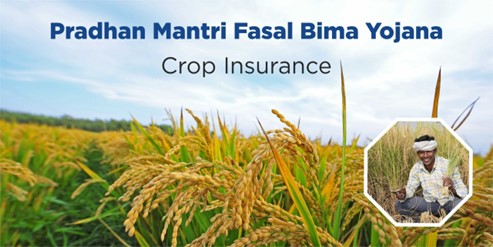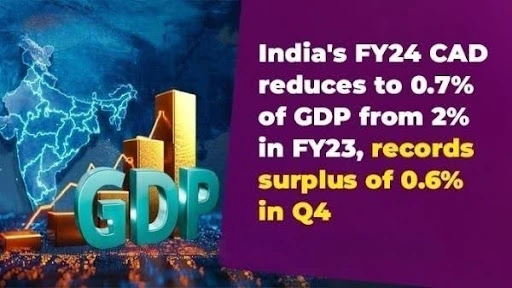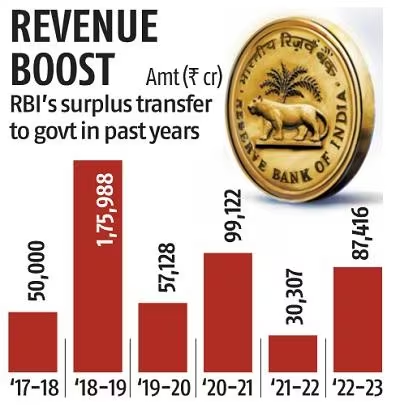Tuesday, 9th July 2024
The ANRF Plan Has Got Off on the Wrong Foot
Why in the news ?
- In 2023, India's Parliament passed the Anusandhan National Research Foundation (ANRF) Bill, aimed at revitalising academic research in the country, particularly within universities and colleges.
- The initiative aims to foster an environment conducive to research by enhancing funding and promoting collaboration with industry partners.
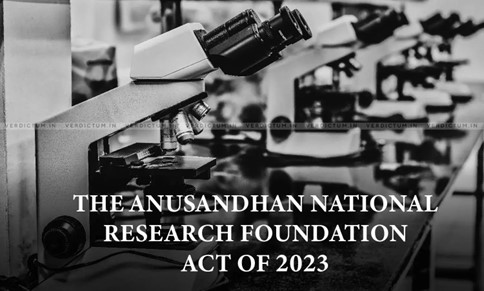
Objectives of the ANRF:
- Enhancing Research Infrastructure:
- Upgrade laboratories and provide advanced research tools, focusing on state universities to overcome historical resource limitations.
- Reducing Bureaucratic Hurdles:
- Simplify and expedite research funding processes, criticised for being slow and stifling innovation.
- Fostering Industry-Academia Collaboration:
- Enhance practical applications of academic research through partnerships with industry, aiming to drive global competitiveness.
- Increasing Research Funding:
- Boost overall research funding from governmental and non-governmental sources, crucial for a sustainable research ecosystem.
- Building a Robust Research Ecosystem:
- Support interdisciplinary research and translate findings into policies that benefit society, nurturing young researchers.
Initial Enthusiasm Surrounding ANRF:
- Positive Reception by the Scientific Community:
- Welcomed for reducing bureaucratic constraints, enhancing infrastructure, and providing better funding opportunities.
- Potential for Academic Excellence:
- Expected to elevate research standards, making Indian institutions globally competitive and fostering international collaborations.
- Industry Interest:
- Viewed as a platform to innovate and develop commercial technologies through university collaborations.
- Government Support:
- Backed as a strategic move to address longstanding research funding issues, aligning with economic and technological goals.
Critical Flaws in ANRF Implementation:
- Governance and Representation Issues:
- Criticised for a board and council lacking representation from state universities and sufficient industry voices, hindering effective decision-making.
- Exclusion of Ground Level Educators:
- Oversight in governance, lacking input from educators familiar with systemic challenges, leading to inefficiencies.
- Lack of Industry and Diverse Representation:
- Insufficient representation from Indian industry and diverse backgrounds, essential for achieving funding goals and practical research applications.
- Funding and Operational Challenges:
- Operational inefficiencies, including bureaucratic hurdles in grant management and funding disbursement, impacting timely research support.
Future Directions for ANRF
● Broadening Representation:
○ Involving representatives from State and Central Universities to meet broader academic needs.
○ Increasing participation of Indian industry leaders to enhance collaboration and relevance to practical challenges.
○ Engaging practising natural and social scientists for insights into specific research requirements.
○ Including entrepreneurs to foster innovation and practical applications.
● Reducing Bureaucratic Hurdles: To operate efficiently:
○ Simplify grant processes, including applications, approvals, and disbursements.
○ Provide clear, consistent guidelines for reporting and compliance.
Conclusion
The ANRF has the potential to revolutionise India's research landscape, contingent upon addressing current governance and operational deficiencies. By embracing inclusive representation, restructuring committees, and improving funding processes, ANRF can catalyse a dynamic research ecosystem that positions India at the forefront of global innovation
|
UPSC civil services examination PYQ Mains Q:1 Scientific research in Indian universities is declining, because a career in science is not as attractive as are business professions, engineering or administration, and the universities are becoming consumer-oriented. Critically comment. (2014) |
Source: TH
Crop insurance coverage declines in FY24
Why in the news?
- General insurance companies reduced their crop insurance under PMFBY in FY24 despite government efforts to expand coverage.
- The 32% fall in premium income by the state-owned Agriculture Insurance Company (AIC), from Rs 14,619 crore to Rs 9,890 crore, led to the decline, per General Insurance Council data.
Pradhan Mantri Fasal Bima Yojana (PMFBY):
- About:
- PMFBY is an insurance service for farmers for their yields, launched in 2016 by the Ministry of Agriculture & Farmers Welfare.
- The new Crop Insurance Scheme follows the One Nation One Scheme theme.
- PMFBY replaced the National Agricultural Insurance Scheme (NAIS) and the Modified NAIS.
- It incorporates the best features of previous schemes while eliminating their shortcomings.
- Objectives:
- To provide insurance coverage and financial support to farmers in the event of failure of notified crops due to natural calamities, pests, and diseases.
- To stabilise farmers' income to ensure their continuance in farming.
- To encourage farmers to adopt innovative and modern agricultural practices.
- To ensure the flow of credit to the agriculture sector.
Key Features of the PMFBY:
- Premium Rates:
- Farmers pay a uniform premium of 2% for all Kharif crops and 1.5% for all Rabi crops.
- For annual commercial and horticultural crops, farmers pay a 5% premium.
- The government bears the balance premium, shared equally by the central and state governments.
- The aim is to provide a fully insured amount to farmers against crop loss due to natural calamities.
- Area-Based Approach:
- The scheme is implemented on an 'Area Approach basis,' i.e., Defined Areas for each notified crop for widespread calamities.
- The unit of insurance is the Village/Village Panchayat level for major crops and a unit above the level of Village/Village Panchayat for other crops.
- All insured farmers in a unit of insurance, defined as a "Notified Area" for a crop, are assumed to face similar risk exposures.
- No Upper Limit to Subsidy:
- There is no upper limit on government subsidy. Even if the balance premium is 90%, it will be borne by the government.
- Use of Technology:
- Technology use is encouraged to a great extent, such as using smartphones to capture and upload crop cutting data to reduce claim payment delays and remote sensing to reduce the number of crop cutting experiments.
- Exemptions from Tax Liabilities:
- Services involved in the scheme's implementation are exempt from Service Tax liability.
- Beneficiaries to be Covered:
- All farmers growing notified crops in a notified area during the season with an insurable interest in the crop are eligible.
- The scheme is voluntary for all farmers from Kharif 2020, whereas it was previously compulsory for farmers with a Crop Loan account or Kisan Credit Card (KCC) account.
- Risks Covered Under the Scheme:
- Comprehensive risk insurance covers yield losses due to non-preventable risks like natural fire, lightning, storm, hailstorm, cyclone, typhoon, tempest, hurricane, tornado, flood, inundation, landslide, drought, dry spells, pests, and diseases.
- Indemnity claims up to 25% of the sum-insured can be made for prevented sowing due to adverse weather.
- Post-harvest losses coverage is available for up to 14 days from harvesting for crops kept in “cut & spread” condition to dry in the field.
- Losses from localised risks like hailstorm, landslide, and inundation affecting isolated farms are also covered.
Crop Insurance Coverage Declines in FY24:
- Decline in Insurance Coverage:
- In FY24, general insurance companies reduced their participation in the PMFBY despite government efforts to expand farm sector insurance.
- The gross direct premium underwritten declined by 4.17% to Rs 30,677 crore from Rs 32,011 crore the previous year.
- Even as farmers suffered crop losses from adverse weather conditions. This decline followed an 8.66% rise to Rs 29,465 crore in FY23.
- A significant factor was the 32% drop in premium income by the state-owned Agriculture Insurance Company (AIC).
- Performance of PMFBY in FY24:
- In FY24, the PMFBY scheme covered nearly 4 crore farmers and over 50 crops.
- More than 55% of insured farmers were non-loanee, mainly enrolled through common service centres (CSCs), with 4 crore farmer applications registered.
- To expand PMFBY coverage, the Ministry of Agriculture and Farmer Welfare launched the AIDE (App for Intermediary Enrolment) in Kharif 2023, allowing intermediaries to enrol non-loanee farmers.
- This initiative involved insurance brokers, resulting in 71% of enrollments through Point of Salespersons (PoSPs), covering 6.88 lakh farmer applications and over 4.15 lakh hectares across 11 states and 12 insurers.
|
UPSC Civil Services Examination Previous Year Question (PYQ) Prelims Q:1 With reference to ‘Pradhan Mantri Fasal Bima Yojana’, consider the following statements: (2016)
Which of the statements given above is/are correct? (a) 1 only (b) 2 only (c) Both 1 and 2 (d) Neither 1 nor 2 Ans: (b) |
Source: IE
Hurricane Beryl’s record early intensification
Why in the News?
- Hurricane Beryl has become the earliest storm on record in the Atlantic hurricane season to achieve Category 5 status.
- It recently caused extensive damage across the Caribbean islands and made landfall in Texas.
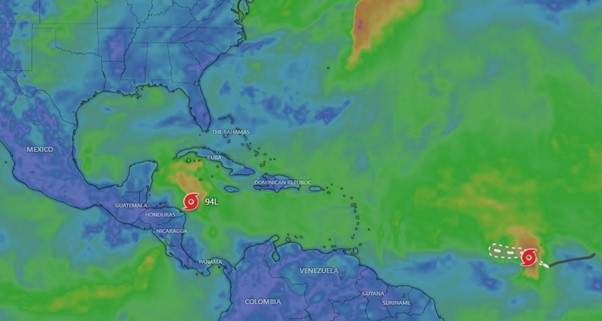
About Hurricane:
- A hurricane is a powerful tropical storm characterised by strong winds, heavy rainfall, and low atmospheric pressure. It is known as a cyclone or typhoon depending on the region it occurs in.
Key Characteristics of Hurricanes:
- Low Pressure Centre: Hurricanes have a distinct centre of low atmospheric pressure called the eye, surrounded by a ring of intense thunderstorms known as the eyewall.
- Strong Winds: Hurricanes produce powerful winds that exceed 74 miles per hour (119 kilometres per hour).
- Heavy Rainfall: They generate heavy rainfall leading to flooding and storm surges along the coast.
- Formation: Hurricanes form over warm ocean waters with sea surface temperatures typically above 26 degrees Celsius, fueled by warm, moist air rising from the ocean's surface.
- Categories: Hurricanes are classified from Category 1 (weakest) to Category 5 (strongest) based on sustained wind speeds, with Category 5 storms bringing winds of 252 kmph or higher.
Beryl’s Record Early Intensification:
- Hurricane Beryl intensified rapidly, becoming a Category 5 storm earlier than any other recorded storm in the Atlantic hurricane season.
- It caused severe flooding and destructive winds across Jamaica, Grenada, Saint Vincent and the Grenadines, and northern Venezuela, resulting in multiple fatalities.
- Beryl subsequently made landfall in Texas as a Category 1 hurricane, causing widespread power outages and flooding in the state.
Beryl’s Record Early Intensification:
- Hurricane Beryl's rapid intensification into a Category 5 storm within the Atlantic hurricane season has sparked considerable interest and concern due to its unprecedented timing and strength.
Key Events:
- On June 28, starting as a tropical depression with winds of 56.3 kmph, Beryl swiftly escalated into a hurricane within 24 hours.
- Within the subsequent 24-hour period, it intensified further, reaching Category 4 status.
- This marked Beryl as the first Category 4 hurricane to form in June, a month typically devoid of such powerful storms.
- Historically, the earliest emergence of a Category 4 hurricane was Hurricane Dennis in July 2005.
- Making landfall on Grenada's Carriacou Island on July 1, Beryl maintained Category 4 strength with sustained winds exceeding 241 kmph.
- As it traversed the Caribbean Sea, Beryl continued to strengthen, achieving Category 5 status by July 2.
- This classification made Beryl the earliest Category 5 hurricane recorded during the Atlantic hurricane season.
- According to NOAA, Beryl also set a record as the strongest July Atlantic hurricane, boasting winds reaching 265.5 kmph.
Factors Contributing to Early Category 5 Status:
- The typical Atlantic hurricane season spans from June to November, with major hurricanes typically emerging in September due to gradual ocean warming.
- Beryl's early formation and intensity are attributed to unusually warm ocean temperatures prevailing since 2023.
- Both sea surface temperatures and ocean heat content have surpassed the 2013-2023 average, fostering an environment conducive to rapid storm development.
- Atmospheric scientists note that warm water depths of 100 to 125 metres inhibit cooler water from surfacing, thereby sustaining Beryl's intensity.
Source: IE
Employment Rate Rises to 6% in FY24
Why in the News?
- India's employment rate increased to 6% in the fiscal year ending March 31, 2024, up from 3.2% in 2022-23, according to data released by the Reserve Bank of India (RBI).
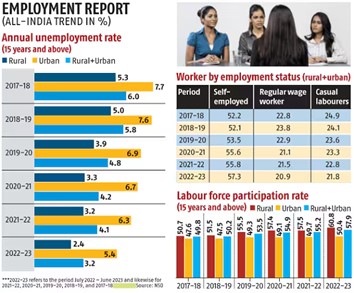
RBI’s Latest Report:
- The RBI released data from its India KLEMS Database, analysing productivity across 27 industries in the Indian economy.
- Key sectors covered include agriculture, manufacturing, and services.
Key Takeaways:
- Total employment in India reached 643.3 million in FY24, up from 596.7 million in FY23.
- Urban unemployment rate decreased slightly from 6.8% to 6.7% from January to March 2023 to 2024.
- Female unemployment rate declined from 9.2% to 8.5% over the same period.
- Labour Force Participation Rate (LFPR) in urban areas increased from 48.5% to 50.2%.
- Worker Population Ratio (WPR) for individuals aged 15 years and above rose from 45.2% to 46.9%.
Key Terms of the Report:
- Labour Force Participation Rate (LFPR):
- LFPR measures the percentage of people aged 15 or older who are either employed or actively seeking work.
- It reflects the demand for jobs within the labour force.
- Employment Rate:
- The employment rate is the percentage of employed persons relative to the total population.
- It indicates the proportion of the population that is currently employed.
- Unemployment Rate:
- The unemployment rate measures the percentage of adults in the labour force who do not have jobs.
- It provides insights into the availability of jobs and the state of the labour market.
- Periodic Labour Force Survey (PLFS):
- Launched by the National Statistics Organisation (NSO) in April 2017.
- Aims to provide accurate and timely data on employment and unemployment.
- Conducted every three months to capture dynamics in labour force participation and employment status in urban areas (Current Weekly Status - CWS).
- Covers both rural and urban areas to measure labour force estimates under usual status and Current Weekly Status.
Source: ET
PLI Scheme for White Goods
Why in the News?
- The Department for Promotion of Industry and Internal Trade (DPIIT) announced the reopening of the application window for the production-linked incentive (PLI) scheme for white goods.

What are White Goods?
- White goods or consumer durables encompass significant household appliances, including -
- Air conditioners (ACs), LED lights, dishwashers,
- Clothes dryers, drying cabinets,
- Freezers, refrigerators,
- Kitchen stoves, water heaters, microwave ovens, induction cookers, and
- Washing machines.
- India allows 100% foreign direct investment (FDI) under the automatic route into the consumer durable goods manufacturing industry.
- The white goods industry in India has exhibited robust growth in recent years, with an estimated market value of US$13.66 billion in the fiscal year 2021.
- Within this industry, the most substantial market shares were captured by ACs, refrigerators, and LED products.
- India’s white goods market is projected to surpass US$21 billion by 2025, at a compound annual growth rate (CAGR) of 11%.
What are PLI Schemes?
- The PLI Schemes are a strategic initiative by the Government of India, aligned with the vision of ‘Atmanirbhar Bharat’ (or Self-Reliant India).
- The core objectives of the PLI Schemes are to
- Improve efficiency, foster economies of scale within the manufacturing sector,
- Position Indian manufacturers as globally competitive, thereby facilitating their integration into global value chains, and
- Foster domestic manufacturing as a catalyst for India’s economic growth and employment generation.
- The PLI Schemes involve significant financial allocations, with a total outlay of INR 1.97 trillion (over US$26 billion) for 13-14 key sectors.
- All sectors approved under the PLI Schemes adhere to a broad framework centred around new and emerging technologies.
What is the PLI Scheme for White Goods?
- Approval and Implementation: Approved by the Union Cabinet on April 7, 2021, and notified by DPIIT on April 16, 2021.
- Duration and Outlay: Implemented over a 7-year period from FY 2021-22 to FY 2028-29, with a total outlay of ₹6,238 crore.
- Objectives: Aims to develop a complete component ecosystem for the air conditioners and LED lights industry in India. It seeks to increase domestic value addition from the current 15-20% to 75-80%.
- Benefits: Encourages investment in manufacturing capabilities, enhances employment opportunities, and integrates Indian manufacturers into global supply chains.
- Current Status: 66 applicants have been selected under the scheme, committing an investment of ₹6,962 crore. Leading brands like Daikin, Panasonic, Havells, and Syska are among the beneficiaries
Source: TH
Digital Bharat Nidhi
Why in the News?
- In a renewed effort to enhance telecom connectivity in rural areas, the Department of Telecommunications (DoT) has released draft rules to operationalise the Digital Bharat Nidhi.

Digital Bharat Nidhi (DBN):
- Background - Universal Service Obligation Fund (USOF)
- The USOF was established to provide telecom services in remote and rural areas at affordable prices through a universal access levy, a percentage of revenue earned by operators under various licences.
- USOF is a pool of funds generated by a 5% Universal Service Levy charged upon all telecom fund operators on their Adjusted Gross Revenue (AGR).
- The goal is to use this money to help expand telecom networks in remote and rural areas.
- Private companies might avoid these areas because they don't make much profit there.
- USOF was given statutory status in December 2003 through amendments to the Indian Telegraph Act (now replaced by the Telecom Act, 2023).
- About
- The DBN was established through the Telecommunications Act, 2023.
- It would replace the erstwhile Universal Service Obligation Fund (USOF).
Features of DBN:
- Transfer of Funds:
- According to the Telecom Act, telecom companies' contributions to the Digital Bharat Nidhi (DBN) are first credited to the Consolidated Fund of India (CFI).
- CFI receives all government revenues, including loans and repayments, and covers government expenses.
- The Centre will transfer the collected funds to the DBN periodically.
- Fund Utilisation
- Funds from the DBN will be used to:
- Promote telecommunication services in underserved rural, remote, and urban areas.
- Fund research and development of telecom services, technologies, and products.
- Support pilot projects and provide consultancy and advisory assistance to improve connectivity.
- Introduce new telecom services, technologies, and products.
- The DBN will fund projects to provide targeted telecommunication access for underserved groups like women, persons with disabilities, and economically and socially weaker sections.
- Funds from the DBN will be used to:
- Appointment of Administrators
- According to draft rules from the DoT, the Centre will appoint an "administrator" to select "DBN implementers" through bidding or applications.
- This administrator will decide how to provide funding on a case-by-case basis, which may include full, partial, or co-funding, as well as market risk mitigation and risk capital.
- Telecom Services on an Open and Non-Discriminatory Basis
- DBN implementers receiving funding must share and provide telecom networks and services on an open and non-discriminatory basis, following the administrator's instructions.
- Criteria for Schemes and Projects Funded by the DBN
- The schemes and projects funded by the DBN must meet criteria such as introducing:
- Next-generation telecom technologies in underserved areas,
- Improving affordability of services, promoting innovation and research,
- Commercialising indigenous technologies,
- Developing relevant standards, and
- Encouraging telecom start-ups, including equipment manufacturing.
- The schemes and projects funded by the DBN must meet criteria such as introducing:
Underutilisation of USOF:
- Since its establishment in 2003, the USOF has faced criticism for underutilization.
- Between 2017 and 2022, the government collected Rs 41,740 crore from telecom companies for the USOF but used only Rs 30,213 crore (about 72%).
- Notably, in 2019-20, out of Rs 7,962 crore collected, only Rs 2,926 crore was used.
- In FY23, expenditure estimates were revised to Rs 3,010 crore, significantly lower than the budgeted Rs 9,000 crore.
- A major reason for this underutilization is the underspending on the BharatNet project for village fibre connectivity
Source: IE
Jagannath Temple
Why in the news ?
- The high-level committee, chaired by an Orissa High Court judge, has expedited the process of opening the Ratna Bhandar, the temple treasury, after 46 years.

About Shree Jagannath Temple:
- Location: Puri, Odisha.
- Deity: Dedicated to Lord Jagannath, a form of the Hindu deity Vishnu.
- History: Believed to be built during the reign of King Anantavarman Chodaganga Deva of the Eastern Ganga dynasty in the 12th century.
Architecture:
- Style: Kalinga architecture, prevalent in the Odisha region.
- Complex: Includes shrines, gardens, and sacred tanks, creating a serene atmosphere for devotion.
- Sanctum Sanctorum: Houses the idols of Lord Jagannath, Balabhadra, and Subhadra.
- Chakra: A 20-foot-high wheel at the pinnacle of the temple, visible from any part of the city.
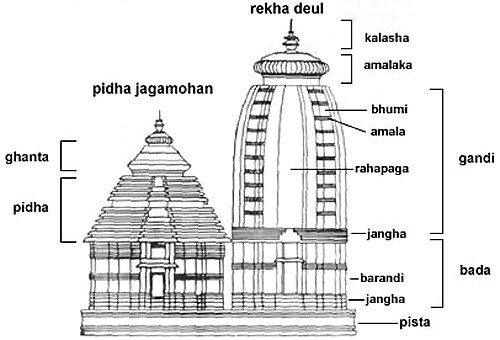
Ratha Yatra Festival:
- Association: Linked to Lord Jagannath temple.
- Commemoration: Jagannath's annual visit to Gundicha Temple via Mausi Maa Temple near Balagandi Chaka, Puri.
- Timing: Begins on the second day of the bright half of the lunar month of Ashadha (June–July) and lasts for nine days.
- Chariots: Deities are taken out and placed on three massive chariots.
Significance:
- One of the four sacred pilgrimage sites known as the Char Dhams.
- A UNESCO World Heritage Site.
Source: TH
New Spider Species
Why in the news ?
- Researchers from Christ College, Irinjalakuda, have discovered two new species of litter-dwelling jumping spiders in the evergreen forests of the southern Western Ghats.

About the New Spider Species:
- The newly discovered species, Habrocestum swaminathan and Habrocestum benjamin, have been added to the illustrious roster of the genus Habrocestum.
- These spiders play a crucial role in natural pest control and serve as vital indicators of ecosystem health.
Habrocestum swaminathan:
- Discovery Location: Banks of the Kunthi river.
- Naming: Named after M.S. Swaminathan for his contributions to science and conservation efforts in Silent Valley, where the Kunthi river originates.
Habrocestum benjamin:
- Discovery Location: Thusharagiri, one of the foothills of the Nilgiri biosphere reserve.
- Description: Attractive with beautiful colour patches, spotted near the Thusharagiri waterfalls, a busy tourist destination.
- Naming: Named after Suresh P. Benjamin, a Sri Lanka-based jumping spider specialist.
Source: TH
Bharat Bill Payment System (BBPS)
Why in the news ?
- The Reserve Bank of India (RBI) recently mandated that all credit card bill payments via third-party applications must now be routed through the Bharat Bill Payment System (BBPS).
 About Bharat Bill Payment System (BBPS):
About Bharat Bill Payment System (BBPS):
- Conceptualization: BBPS is a payment channel system conceptualised by the RBI and driven by the National Payments Corporation of India (NPCI).
- Purpose: It serves as a one-stop payment platform for all bills, providing an interoperable and accessible “Anytime Anywhere” bill payment service with certainty, reliability, and safety of transactions.
- Features:
- Multiple payment modes.
- Instant confirmation of payment receipt.
- Integrated platform connecting banks, non-banks, billers, payment service providers, and retail bill outlets.
- Convenience of payment by cataloguing various utility providers on one platform.
- Bill Collection Categories:
- Electricity, telecom, mobile postpaid, DTH, gas, and water bills.
- Other payments like school/university fees, municipal taxes, mutual funds and insurance premiums, and various government taxes, as decided by the RBI, will be incorporated.
- Payment Channels:
- Physical payment collection outlets (bank branches, agent collection stores, etc.).
- Digital channels (apps, websites, etc.) across India.
- Instant confirmation of payment via SMS or receipt.
Source: FE
Project PARI
Why in the news ?
- The Ministry of Culture, Government of India, has initiated Project PARI (Public Art of India) during the 46th Session of the World Heritage Committee Meeting in New Delhi from July 21-31, 2024.
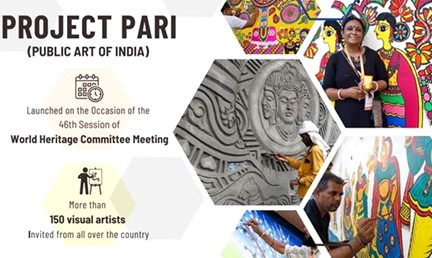
About Project PARI:
- Objective: Project PARI aims to stimulate dialogue, reflection, and inspiration, enhancing the dynamic cultural fabric of the nation.
- Platform: It provides a platform to elevate the aesthetic and cultural outlook of Delhi, adding grandeur to the city’s rich historical legacy.
- Significance: Art in public spaces showcases the nation's rich and diverse cultural heritage.
- Proposed Sculptures: The sculptures being created include themes such as:
- Tributes to nature
- Ideas inspired by the Natyashastra
- Gandhi ji
- Toys of India
- Hospitality
- Ancient knowledge
- Naad or Primeval Sound
- Harmony of life
- Kalpataru – the divine tree
- Women Artists: Women artists have been integral to Project PARI, demonstrating Bharat’s NARI SHAKTI.
- Execution: The initiative is being executed by the Lalit Kala Akademi, an autonomous institution under the Ministry of Culture.
Source: PIB
India to sign, ratify High Seas Treaty
Why in the news?
- India has decided to sign and ratify the High Seas Treaty, a global agreement for conservation and protection of biodiversity in the oceans.
- The High Seas Treaty, also known as the agreement on Biodiversity Beyond National Jurisdictions (BBNJ), was negotiated in March 2023.
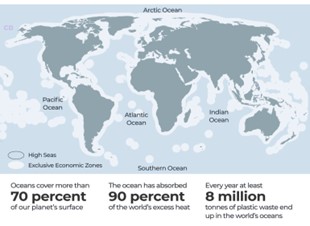
About the High seas:
- The high seas are the parts of the ocean that are not included in the exclusive economic zones, territorial sea or internal waters of a State.
- Water beyond 200 nautical miles from the coast of a country is known as high sea.
- High seas are the areas of the ocean for which no one nation has sole responsibility for management.
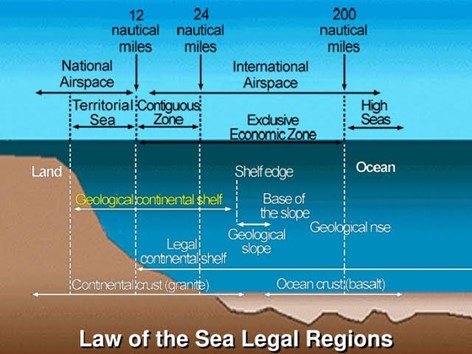
Need for UN high seas treaty:
- Ocean and biodiversity
- The high seas comprise 64 percent of the ocean surface, and about 43 per cent of the Earth.
- These areas are home to about 2.2 million marine species and up to a trillion different kinds of microorganisms.
- Ocean and global climate
- Oceans are an integral part of the global climate cycle, and perform a range of ecological services including absorption of carbon dioxide and excess heat.
- Hence, this treaty is being considered as a landmark in the efforts to keep the planet habitable.
- Unregulated human activities
- Climate change is already influencing, and is being influenced by, ocean systems, and is exacerbating the pressures on marine biodiversity from unregulated human activities.
- It is these specific challenges — a combination of climate change, biodiversity, and pollution — that the High Seas Treaty seeks to address.
- UNCLOS and concerns regarding the biodiversity
- Though UNCLOS asks countries to protect the ocean ecology and conserve its resources, it does not provide the specific mechanisms or processes to do so.
- Hence, it is believed that the High Seas Treaty will work as an implementation agreement under the UNCLOS.
- This is similar to the Paris Agreement working under the UN Framework Convention on Climate Change (UNFCCC).
About the UN High Seas Treaty:
- The UN High Seas Treaty, officially known as the Biodiversity Beyond National Jurisdictions (BBNJ) agreement, is a significant international effort agreed under the United Nations Convention on the Law of the Sea (UNCLOS).
- Adopted in 1982 and coming into force in 1994, UNCLOS provides the framework for managing and using the world's oceans and their resources.
- However, it has limitations in protecting the vast expanses of ocean beyond national jurisdiction, which constitute about two-thirds of the Earth's oceanic surface.
Key Provisions of the Treaty:
- Marine Protected Areas (MPAs):
- These are designated zones aimed at conserving ocean systems and biodiversity under stress from human activities or climate change. Similar to terrestrial national parks, MPAs in the high seas will be highly regulated to promote conservation efforts. Currently, only about 1.44% of the high seas are protected.
- Sustainable Use of Marine Genetic Resources:
- The treaty addresses the extraction and utilisation of genetic information from marine organisms. It aims to ensure that benefits arising from such resources are equitably shared without restrictive intellectual property controls, promoting open access to generated knowledge.
- Environmental Impact Assessments:
- Under the treaty, major activities in the high seas that could significantly impact marine ecosystems must undergo environmental impact assessments. Results of these assessments are to be shared internationally, fostering transparency and informed decision-making.
- Capacity Building and Technology Transfer:
- The treaty emphasises support for small island states and landlocked nations, enhancing their ability to participate effectively in conservation efforts through capacity building and technology transfer.
- Creation of a New Management Body:
- A new international body will be established to oversee the conservation of ocean life and the establishment of MPAs in the high seas, ensuring coordinated global efforts.
|
Status of the Treaty: ● The treaty will become international law 120 days after at least 60 countries formally ratify it. Currently, 91 countries have signed the treaty, but only eight have completed the ratification process. |
India to sign, ratify High Seas Treaty:
- India has decided to sign and ratify the High Seas Treaty.
- The High Seas Treaty, once it is ratified by the requisite number of countries and becomes international law, would operate under the UNCLOS framework, and become one of its implementing instruments.
- The UN Convention on the Law of the Seas, or UNCLOS, defines the rights and duties of the country, and lays down the general principles of acceptable conduct in the oceans.
- There are already two similar agreements under UNCLOS:
- one that regulates the extraction of mineral resources from ocean beds, and
- the other about conservation of migratory fish stocks.
Source: IE
Share the article
Edukemy’s Current Affairs Quiz is published with multiple choice questions for UPSC exams
MCQ
Get Latest Updates on Offers, Event dates, and free Mentorship sessions.

Get in touch with our Expert Academic Counsellors 👋
FAQs
UPSC Daily Current Affairs focuses on learning current events on a daily basis. An aspirant needs to study regular and updated information about current events, news, and relevant topics that are important for UPSC aspirants. It covers national and international affairs, government policies, socio-economic issues, science and technology advancements, and more.
UPSC Daily Current Affairs provides aspirants with a concise and comprehensive overview of the latest happenings and developments across various fields. It helps aspirants stay updated with current affairs and provides them with valuable insights and analysis, which are essential for answering questions in the UPSC examinations. It enhances their knowledge, analytical skills, and ability to connect current affairs with the UPSC syllabus.
UPSC Daily Current Affairs covers a wide range of topics, including politics, economics, science and technology, environment, social issues, governance, international relations, and more. It offers news summaries, in-depth analyses, editorials, opinion pieces, and relevant study materials. It also provides practice questions and quizzes to help aspirants test their understanding of current affairs.
Edukemy's UPSC Daily Current Affairs can be accessed through:
- UPSC Daily Current Affairs can be accessed through Current Affairs tab at the top of the Main Page of Edukemy.
- Edukemy Mobile app: The Daily Current Affairs can also be access through Edukemy Mobile App.
- Social media: Follow Edukemy’s official social media accounts or pages that provide UPSC Daily Current Affairs updates, including Facebook, Twitter, or Telegram channels.

